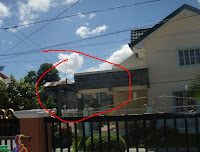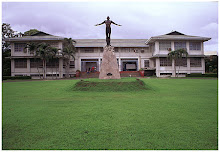The Thin Line between the Rich and the Poor
An Essay on Class Inequality in the Philippines
“When a country is in progress, it is a shame to be poor and unfortunate; but when a country is in chaos, it is a shame to be rich and a politician.”
-Confucius
This picture shows a beautiful house inside a nice subdivision. From the looks of it, one might say that the people living in this subdivision are well-off and wealthy. But if you look closely, you could see that beyond the walls of this subdivision lies the real issue.
You would notice that behind the beautiful house is a thick wall that separates the subdivision from the other side, where the houses are small and uninhabitable.
This is the real picture; the image of the reality that we are facing right now; the portrait of the crisis our society has long been struggling with— class inequality. For many years, our society has been dealing with this problem, which started long before, and has evolved into a phenomenon that has affected us greatly.
Since the Spanish era, class inequality has been evident. The ones with Spanish blood were highly privileged rather than the locals. The European-born Spaniards, or the Peninsulares, were the highest among the ranks, followed by the Philippine-born Spaniards, or the Insulares. They were then followed by the local elites, who were formerly datus before the Spaniards came to conquer. Next to them were the Chinese mestizos and the merchants (inquilinos and chino-sangleys). And at the bottom were the poor tenants and the landless peasants, commonly referred to as the indios. Those were the classes that formed the social triangle during the Spanish era.
The American colonial period was no different from the Spanish era. Although social classes have changed, the reality that inequality cannot be eradicated still remained. In fact, the space between the elites and the less privileged ones grew larger.
Nowadays, the rising gap between the rich and the poor has become more apparent. It is clearly manifested in this picture, where the only thing that divides both worlds, is a wall. You could see the distinct reality that all of us are experiencing. You could observe the big difference between the two worlds.
Looking at this photo, I wondered how some people managed to build large and elegant houses while most of us couldn’t even afford to buy food and starve to death. Then I realized that this has been the effect of corruption, of selfishness, of lack of civility. This is the image of cultural malaise.
A lot of questions keep running through my mind. Questions like, how can we narrow the gap between the rich and the poor? What will happen if the less fortunate people outnumber those well-off and wealthy people?
It is not impossible for such occurrence to happen. One of these days, we might end up facing the consequences brought about by hatred and fury conveyed within the less fortunate people. When that happens, we have to be ready, or better yet, we must find ways in order to prevent something like that from happening. No one said that everything was going to be easy, but no one also said that nothing is possible. If we could only stand up and work our way out of this together, we can succeed in undermining rigid social roles and hierarchies.
POSC 1-B









No comments:
Post a Comment